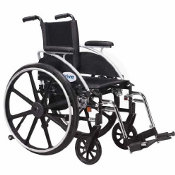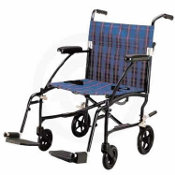Manual Wheelchairs
The manual wheelchair is one of the most common and well known types of wheelchairs. It is also the oldest, with models dating back many thousands of years. As the name implies, a manual wheelchair is propelled by human power, either by the person using the wheelchair or by a caretaker. There are a number models of manual wheelchairs, but they can be broken down into three general categories; Self-propelled, Attendant Propelled, or Wheelbase wheelchairs.
Self-Propelled:
 Typically when someone uses the phrase manual wheelchair, they are referring to a self-propelled wheelchair.
Typically when someone uses the phrase manual wheelchair, they are referring to a self-propelled wheelchair.
Most use a design that is based off of the E & J Manual Wheelchair, which was first developed during the early twentieth century. These manual wheelchairs use a steel or aluminum tube frame and cloth seat. A large set of wheels, typically with a diameter between 20†and 26,†are installed in the rear of the wheelchair. A smaller set of wheels is positioned in the front of the wheelchair. The large rear wheels allow the person using the wheelchair to move the chair, using a rail that extends from the side of the wheel.
Typically, most self propelled wheelchairs can be folded when not in use. On average, they usually weigh less than 40 pounds and depending on the model, can usually support around 250 pounds. Of course, heavy duty models are available that support much more weight, with some capable of supporting over 600 pounds.
Lighter manual wheelchairs are also available and are often popular with those who have difficulty using a traditional manual wheelchair. These models which usually weigh around 27 – 35 pounds, require less effort to move than a full sized manual wheelchair.
Ultra-Light wheelchairs are also available, which can weigh as little as 14 pounds. This makes them very easy to transport and they are usually much more maneuverable, making them a popular choice for those who are very active.
Those who use self-propelled wheelchairs often become very adept ad doing so, able to overcome curbs and in some cases staircases. However, they require a good deal of upper body strength and can be very hard to use for some.
Anti-tip casters are installed on the rear of most manual wheelchairs and help protect against the wheelchair tipping over too far. When the wheelchair is tipped backwards, the anti-tip casters make contact with the ground preventing the wheelchair from tipping over all the way.
Attendant Propelled:
 Attendant Propelled manual wheelchairs, or transport chairs as they are often called, are often similar in design to a traditional manual wheelchair. They use a similar type of frame, with lightweight steel or aluminum tubing and a cloth fabric chair. They are also very often foldable, so can be placed in the rear of a vehicle.
Attendant Propelled manual wheelchairs, or transport chairs as they are often called, are often similar in design to a traditional manual wheelchair. They use a similar type of frame, with lightweight steel or aluminum tubing and a cloth fabric chair. They are also very often foldable, so can be placed in the rear of a vehicle.
While transport chairs share many similarities with a traditional manual wheelchair, can not be propelled by the person using the wheelchair. Instead, they are operated by someone who walks behind the wheelchair. They also do not have the same large real wheels that a self-propelled wheelchair does and instead often all four wheels are of the same size.
Most transport chairs support 250 pounds, although as with self-propelled chairs, heavy duty transport chairs are available that can support more than 600 pounds. Often the seat of a transport chair is also upgraded, with a reclining back or extra padding.
Wheelbase Wheelchairs
Wheelbase wheelchairs differ from other wheelchairs in that the seat is usually custom molded to accommodate the posture of the user. The seat, which is often covered in memory foam or another type of padding, is designed to fit the body shape of an individual with a complicated posture. Often the base of a wheelbase wheelchair is built to a specific set of standards, while the chair can vary by the person who it is built for.